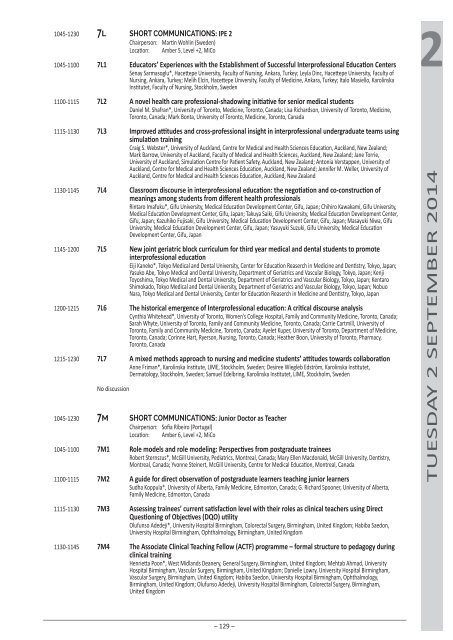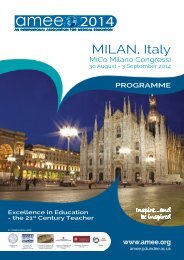Ac1xd
Ac1xd
Ac1xd
Create successful ePaper yourself
Turn your PDF publications into a flip-book with our unique Google optimized e-Paper software.
2TUESDAY 2 SEPTEMBER 20141045-1230 7L SHORT COMMUNICATIONS: IPE 2Chairperson: Martin Wohlin (Sweden)Location: Amber 5, Level +2, MiCo1045-1100 7L1 Educators’ Experiences with the Establishment of Successful Interprofessional Education CentersSenay Sarmasoglu*, Hacettepe University, Faculty of Nursing, Ankara, Turkey; Leyla Dinc, Hacettepe University, Faculty ofNursing, Ankara, Turkey; Melih Elcin, Hacettepe Unıversity, Faculty of Medicine, Ankara, Turkey; Italo Masiello, KarolinskaInstitutet, Faculty of Nursing, Stockholm, Sweden1100-1115 7L2 A novel health care professional-shadowing initiative for senior medical studentsDaniel M. Shafran*, University of Toronto, Medicine, Toronto, Canada; Lisa Richardson, University of Toronto, Medicine,Toronto, Canada; Mark Bonta, University of Toronto, Medicine, Toronto, Canada1115-1130 7L3 Improved attitudes and cross-professional insight in interprofessional undergraduate teams usingsimulation trainingCraig S. Webster*, University of Auckland, Centre for Medical and Health Sciences Education, Auckland, New Zealand;Mark Barrow, University of Auckland, Faculty of Medical and Health Sciences, Auckland, New Zealand; Jane Torrie,University of Auckland, Simulation Centre for Patient Safety, Auckland, New Zealand; Antonia Verstappen, University ofAuckland, Centre for Medical and Health Sciences Education, Auckland, New Zealand; Jennifer M. Weller, University ofAuckland, Centre for Medical and Health Sciences Education, Auckland, New Zealand1130-1145 7L4 Classroom discourse in interprofessional education: the negotiation and co-construction ofmeanings among students from different health professionalsRintaro Imafuku*, Gifu University, Medical Education Development Center, Gifu, Japan; Chihiro Kawakami, Gifu University,Medical Education Development Center, Gifu, Japan; Takuya Saiki, Gifu University, Medical Education Development Center,Gifu, Japan; Kazuhiko Fujisaki, Gifu University, Medical Education Development Center, Gifu, Japan; Masayuki Niwa, GifuUniversity, Medical Education Development Center, Gifu, Japan; Yasuyuki Suzuki, Gifu University, Medical EducationDevelopment Center, Gifu, Japan1145-1200 7L5 New joint geriatric block curriculum for third year medical and dental students to promoteinterprofessional educationEiji Kaneko*, Tokyo Medical and Dental University, Center for Education Reaserch in Medicine and Dentistry, Tokyo, Japan;Yasuko Abe, Tokyo Medical and Dental University, Department of Geriatrics and Vascular Biology, Tokyo, Japan; KenjiToyoshima, Tokyo Medical and Dental University, Department of Geriatrics and Vascular Biology, Tokyo, Japan; KentaroShimokado, Tokyo Medical and Dental University, Department of Geriatrics and Vascular Biology, Tokyo, Japan; NobuoNara, Tokyo Medical and Dental University, Center for Education Reaserch in Medicine and Dentistry, Tokyo, Japan1200-1215 7L6 The historical emergence of Interprofessional education: A critical discourse analysisCynthia Whitehead*, University of Toronto, Women’s College Hospital, Family and Community Medicine, Toronto, Canada;Sarah Whyte, University of Toronto, Family and Community Medicine, Toronto, Canada; Carrie Cartmill, University ofToronto, Family and Community Medicine, Toronto, Canada; Ayelet Kuper, University of Toronto, Department of Medicine,Toronto, Canada; Corinne Hart, Ryerson, Nursing, Toronto, Canada; Heather Boon, University of Toronto, Pharmacy,Toronto, Canada1215-1230 7L7 A mixed methods approach to nursing and medicine students’ attitudes towards collaborationAnne Friman*, Karolinska Institute, LIME, Stockholm, Sweden; Desiree Wiegleb Edström, Karolinska Institutet,Dermatology, Stockholm, Sweden; Samuel Edelbring, Karolinska Institutet, LIME, Stockholm, SwedenNo discussion1045-1230 7M SHORT COMMUNICATIONS: Junior Doctor as TeacherChairperson: Sofia Ribeiro (Portugal)Location: Amber 6, Level +2, MiCo1045-1100 7M1 Role models and role modeling: Perspectives from postgraduate traineesRobert Sternszus*, McGill University, Pediatrics, Montreal, Canada; Mary Ellen Macdonald, McGill University, Dentistry,Montreal, Canada; Yvonne Steinert, McGill University, Centre for Medical Education, Montreal, Canada1100-1115 7M2 A guide for direct observation of postgraduate learners teaching junior learnersSudha Koppula*, University of Alberta, Family Medicine, Edmonton, Canada; G. Richard Spooner, University of Alberta,Family Medicine, Edmonton, Canada1115-1130 7M3 Assessing trainees’ current satisfaction level with their roles as clinical teachers using DirectQuestioning of Objectives (DQO) utilityOlufunso Adedeji*, University Hospital Birmingham, Colorectal Surgery, Birmingham, United Kingdom; Habiba Saedon,University Hospital Birmingham, Ophthalmology, Birmingham, United Kingdom1130-1145 7M4 The Associate Clinical Teaching Fellow (ACTF) programme – formal structure to pedagogy duringclinical trainingHenrietta Poon*, West Midlands Deanery, General Surgery, Birmingham, United Kingdom; Mehtab Ahmad, UniversityHospital Birmingham, Vascular Surgery, Birmingham, United Kingdom; Danielle Lowry, University Hospital Birmingham,Vascular Surgery, Birmingham, United Kingdom; Habiba Saedon, University Hospital Birmingham, Ophthalmology,Birmingham, United Kingdom; Olufunso Adedeji, University Hospital Birmingham, Colorectal Surgery, Birmingham,United Kingdom– 129 –



